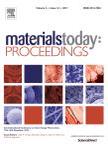版权所有:内蒙古大学图书馆 技术提供:维普资讯• 智图
内蒙古自治区呼和浩特市赛罕区大学西街235号 邮编: 010021

作者机构:Mechatronics Engineering Department Agni College of technology-OMR Thalambur Tamilnadu Chennai 600130 India Garuda Aerospace OMR Tamil Nadu Chennai 600130 India
出 版 物:《Materials Today: Proceedings》 (Mater. Today Proc.)
年 卷 期:2023年第80卷
页 面:492-498页
核心收录:
学科分类:080103[工学-流体力学] 08[工学] 0805[工学-材料科学与工程(可授工学、理学学位)] 080502[工学-材料学] 0825[工学-航空宇航科学与技术] 0701[理学-数学] 0801[工学-力学(可授工学、理学学位)] 0702[理学-物理学]
摘 要:Twin-blade propellers are typically used in applications that require precision flight control and agility due to their high relative efficiency. The thrust produced by twin-blade propellers is low and hence is only used in lightweight drones focused on quick reflexes and speed rather than lifting capacity and stability. The present study focuses on developing a twin-blade propeller model with improved torque and coefficient of performance with reduced vibrations and drag by numerical simulation analysis. The proposed blade design was modeled with a blade angle of 30° to analyze its effects on the generation of propeller torque. The validity and accuracy of the developed numerical simulation model are influenced by the mesh and turbulence parameters of the developed model. In the present work, the turbulence factors were modeled by the shear stress transport model, and the meshing parameters were subjected to a grid convergence study. The peak coefficient of performance (0.5810) and torque (1.1007 Nm) for the proposed twin-blade propeller were observed for V = 15 m/s. © 2022